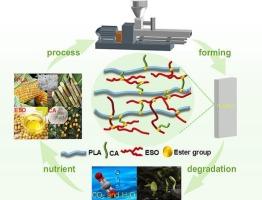基于环氧大豆油的动态酯交换网络增韧聚乳酸
IF 6.3
2区 化学
Q1 POLYMER SCIENCE
引用次数: 0
摘要
在不丧失生物降解性的前提下提高PLA的韧性。本研究通过一种简单高效的制备方法,在聚乳酸(PLA)挤出成型过程中,原位制备了基于环氧大豆油(ESO)和无水柠檬酸(CA)的可逆酯交换网络(VEC)。重点研究了VEC对PLA的增韧性能,发现VEC的r值(CA羧基与ESO环氧基的等效比)、催化体系、聚合时间和VEC含量是影响力学增强的关键参数。结果表明,VEC不仅可以作为成核剂促进PLA结晶,还可以作为增塑剂促进分子链迁移。流变学分析表明,VEC提高了PLA的熔体强度,增强了PLA的剪切减薄行为,从而丰富了PLA基产品的结构复杂性,拓宽了PLA基产品的加工通用性。更重要的是,PLA和VEC的化学相互作用改善了相相容性。值得注意的是,仅添加5 wt% VEC就形成了完整的内部增韧网络,断裂屈服伸长率和冲击强度分别是纯PLA的49.1倍和2.27倍。PLA/VEC废料可通过再挤出有效回收。在回收和重塑过程中,复合材料内部重新建立了相对完整的动态VEC网络,断裂伸长率达到纯PLA的38.4倍,具有很大的应用潜力。PLA/VEC在碱性条件下可在30天内完全降解。本文章由计算机程序翻译,如有差异,请以英文原文为准。

Dynamic transesterification network toughening polylactic acid based on epoxidized soybean oil
To improve the toughness of PLA without loss of biodegradability. In this study, a reversible ester exchange network (VEC) based on bio-based materials—epoxidized soybean oil (ESO) and anhydrous citric acid (CA)—was generated in situ during the extrusion molding process of poly(lactic acid) (PLA) via a simple and efficient preparation method. Focusing on the toughening performance of VEC on PLA, it was found that the R-value of VEC (the equivalent ratio of CA carboxyl groups to ESO epoxy groups), catalytic system, polymerization time, and VEC content were the key parameters influencing the mechanical enhancement. The results demonstrated that VEC acted not only as a nucleating agent to promote PLA crystallization but also as a plasticizer facilitating molecular chain mobility. Rheological analysis showed that VEC enhanced the melt strength of PLA and intensified shear thinning behavior, thereby enriching the structural complexity and broadening the processing versatility of PLA-based products. More importantly, PLA and VEC chemically interacted to improve phase compatibility. Notably, the addition of only 5 wt% VEC resulted in the formation of a complete internal toughening network, yielding elongation at break and impact strength values that were 49.1 times and 2.27 times greater, respectively, than those of neat PLA. PLA/VEC waste products can be effectively recycled via re-extrusion. During the recycling and remodeling process, a relatively complete dynamic VEC network is re-established within the composite, with the elongation at break reaching 38.4 times that of neat PLA, indicating significant application potential. PLA/VEC can undergo complete degradation under alkaline conditions within 30 days.
求助全文
通过发布文献求助,成功后即可免费获取论文全文。
去求助
来源期刊

European Polymer Journal
化学-高分子科学
CiteScore
9.90
自引率
10.00%
发文量
691
审稿时长
23 days
期刊介绍:
European Polymer Journal is dedicated to publishing work on fundamental and applied polymer chemistry and macromolecular materials. The journal covers all aspects of polymer synthesis, including polymerization mechanisms and chemical functional transformations, with a focus on novel polymers and the relationships between molecular structure and polymer properties. In addition, we welcome submissions on bio-based or renewable polymers, stimuli-responsive systems and polymer bio-hybrids. European Polymer Journal also publishes research on the biomedical application of polymers, including drug delivery and regenerative medicine. The main scope is covered but not limited to the following core research areas:
Polymer synthesis and functionalization
• Novel synthetic routes for polymerization, functional modification, controlled/living polymerization and precision polymers.
Stimuli-responsive polymers
• Including shape memory and self-healing polymers.
Supramolecular polymers and self-assembly
• Molecular recognition and higher order polymer structures.
Renewable and sustainable polymers
• Bio-based, biodegradable and anti-microbial polymers and polymeric bio-nanocomposites.
Polymers at interfaces and surfaces
• Chemistry and engineering of surfaces with biological relevance, including patterning, antifouling polymers and polymers for membrane applications.
Biomedical applications and nanomedicine
• Polymers for regenerative medicine, drug delivery molecular release and gene therapy
The scope of European Polymer Journal no longer includes Polymer Physics.
 求助内容:
求助内容: 应助结果提醒方式:
应助结果提醒方式:


